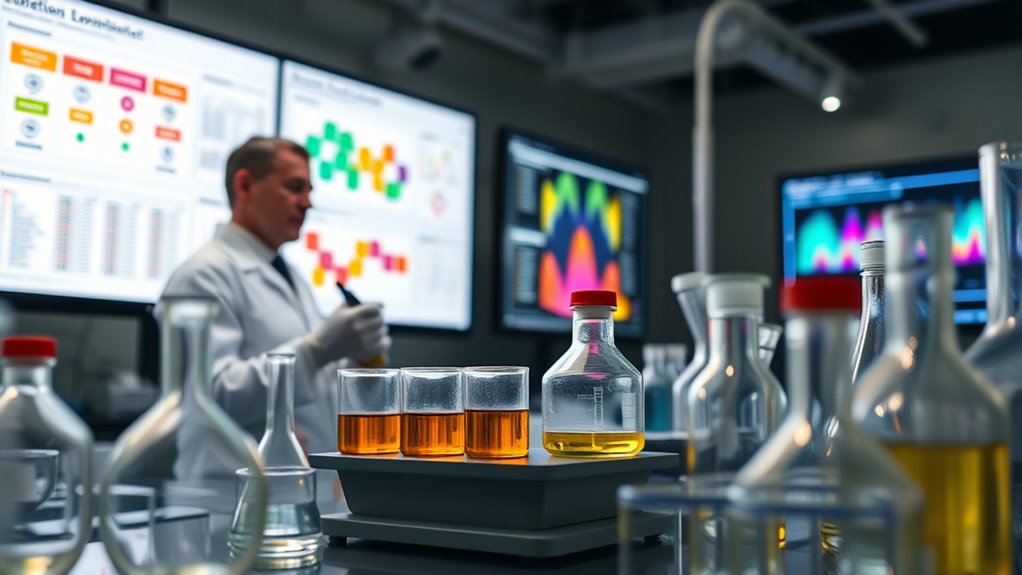To measure the environmental impact of chemicals through a life cycle analysis, start by clearly defining your study’s purpose and boundaries, then collect data on resource use, emissions, and waste across the entire life cycle. Use impact assessment methods like TRACI to evaluate categories such as ecotoxicity, resource depletion, and human health risks. Identifying hotspots helps target improvements. Following established standards and tools guarantees accuracy, while addressing data gaps and uncertainties boosts reliability—keep exploring to learn more.
Key Takeaways
- Define clear scope, boundaries, and impact categories, including resource use, emissions, and ecotoxicity, for comprehensive assessment.
- Collect accurate, facility-level data on raw materials, energy consumption, and emissions from reliable inventories and reports.
- Use impact assessment tools like LCIA, TRACI, and MFA to quantify environmental effects across life cycle stages.
- Identify hotspots by analyzing data on energy, emissions, and waste to target environmental improvements effectively.
- Communicate findings transparently, including assumptions and uncertainties, to support informed decision-making and stakeholder trust.
Defining the Purpose and Boundaries of Chemical Life Cycle Studies

Understanding the purpose and boundaries of a chemical life cycle study is essential to guarantee its relevance and usefulness. First, define why you’re conducting the study—whether for regulatory compliance, product improvement, or environmental labeling. Clarify if you’re evaluating a product, process, or service, and identify your target audience, like regulators, companies, or consumers. The goal and scope influence the study’s depth, scope, and data collection methods. This guides the selection of impact categories, such as greenhouse gases or resource depletion, and shapes the study’s depth. Next, set clear boundaries: decide which life cycle stages to include—cradle-to-gate, cradle-to-grave, or gate-to-gate—and specify geographical and temporal limits. Be explicit about exclusions, like social impacts or minor supply chain elements, to ensure transparency and focus. Additionally, considering environmental impact assessment early in the process helps align the study with sustainability objectives.
Collecting Data on Resource Use and Emissions Throughout Chemical Production
How do you accurately track resource use and emissions during chemical production? You gather data from multiple sources, including reports to programs like the U.S. EPA’s GHGRP and TRI, as well as EU and UN inventories. Facility-level data cover fuel combustion, raw material consumption, and process emissions. To organize this, consider the following:
| Resource Type | Data Collection Method |
|---|---|
| Feedstock (raw materials) | Measure hydrocarbon volumes per batch |
| Process energy | Record fuel and electricity use |
| Emissions from combustion | Install continuous monitoring systems (CEMS) |
| Raw material transportation | Track fuel consumption during transit |
| Emissions from processes | Use onsite sensors and emission inventories |
Tracking these data points helps you understand resource intensity, identify hotspots, and support effective environmental management. Accurate data collection is essential for assessing the environmental impact of chemical manufacturing processes, especially when considering the full life cycle of the materials involved.
Evaluating Environmental Impact Categories Relevant to Chemicals

Evaluating environmental impact categories relevant to chemicals involves systematically identifying and measuring the various ways chemicals can affect ecosystems and human health. You examine ecotoxicity across terrestrial, freshwater, and marine environments, focusing on toxic substances like heavy metals, PAHs, and PCBs. Bioaccumulation potential highlights chemicals that build up in organisms over time, posing long-term risks. You also assess resource depletion by tracking metal and fossil fuel use, along with land occupation and water scarcity. Pollution impacts are evaluated through acidification, eutrophication, and particulate matter formation, which affect air and water quality. Additionally, you consider human health risks, such as carcinogenic effects, ozone depletion, and respiratory issues caused by chemical exposure. Impact categories are often quantified using standardized units, allowing for comparison and aggregation of diverse effects. Incorporating emerging assessment methods can enhance the accuracy and comprehensiveness of these evaluations. This extensive approach helps you understand the full environmental footprint of chemicals.
Utilizing Impact Assessment Methods to Quantify Environmental Effects

Impact assessment methods are essential tools that help you quantify the environmental effects of chemical emissions and resource use throughout a product’s lifecycle. You can target specific footprints, like carbon or water, or assess multiple impact categories simultaneously. Tools such as TRACI provide characterization factors that convert emissions into measurable impact potentials, enabling you to evaluate global warming, eutrophication, and toxicity. Methods like Life Cycle Impact Assessment (LCIA) and Material Flow Analysis (MFA) help you analyze impacts across the entire lifecycle, from production to disposal. The Green Degree (GD) offers a holistic index that integrates multiple impact categories for complex systems. Selecting the right method depends on your scope, data availability, and the level of detail you need, allowing you to prioritize mitigation efforts effectively. Incorporating cybersecurity strategies to protect environmental data can enhance the reliability of impact assessments and ensure data integrity throughout the analysis.
Interpreting Results to Identify Hotspots and Areas for Improvement

Interpreting environmental assessment results is essential for pinpointing hotspots within your product’s lifecycle and guiding targeted improvements. You’ll notice that raw material extraction often dominates impacts due to energy-intensive mining or agricultural inputs. Fundamentally, understanding these impacts helps prioritize areas for efficiency gains and environmental mitigation. Manufacturing processes contribute notably through high energy use, emissions, and hazardous waste, especially in chemical synthesis. Transportation of feedstocks or intermediates adds to CO₂ emissions, particularly across global supply chains. Waste generation during production creates disposal challenges, while in-use phases may involve high energy consumption and chemical degradation, releasing pollutants over time. Additionally, consumer behavior can influence the overall environmental footprint during the product’s use phase, impacting sustainability goals. End-of-life impacts like landfill leaching, incineration emissions, or recycling hurdles highlight areas needing attention. By analyzing these hotspots, you can focus on process optimization, feedstock substitution, or adopting renewable energy to reduce environmental burdens effectively.
Leveraging Software Tools and Standards for Accurate LCA Execution

Leveraging software tools and adhering to established standards are essential steps for ensuring accurate and reliable life cycle assessments (LCAs). You can choose from top solutions like SimaPro, GaBi, Ecochain, OneClick, and OpenLCA, each offering unique features. Industry-leading LCA software can streamline data collection and analysis, reducing errors and increasing efficiency. For renewable chemicals, P6 Technologies provides sector-specific templates and databases, aiding specialized assessments. Open-source options like openLCA are cost-effective and versatile, suitable for various needs. Compliance with standards such as ISO 14040, ISO 14044, and ISO 14067 guarantees consistency, comparability, and regulatory adherence. These tools facilitate data integration, management, and automation, ensuring your inventory data is exhaustive and reliable. Additionally, they support advanced impact analysis, visualization, and customizable reporting, enabling you to interpret results effectively and make informed decisions based on robust LCA data. Incorporating regulatory requirements into your assessment process helps ensure compliance and enhances the credibility of your environmental impact evaluations.
Addressing Data Gaps and Uncertainties in Chemical LCAs

While software tools and standards improve the consistency of chemical LCA calculations, data gaps and uncertainties still pose significant challenges. High uncertainty parameters, like environmental partitioning and toxicity effects, can vary by 3.2–5.5 orders of magnitude, making accurate assessments difficult. Additionally, understanding the divorce process in various states can highlight how legal procedures differ, similar to how environmental assessments vary by parameters and data quality. Critical gaps exist in data for degradation half-lives, fish bioaccumulation, and skin permeation, often with fewer than 100 measurements available. Variability in data collection methods and context-specific relevance further complicate matters, especially since some parameters influence outcomes only in specific scenarios. Uncertainty propagates through toxicity assessments, often overshadowing other factors. Machine learning offers promise by predicting missing data for key parameters, but reliable models require sufficient data. Combining ML with targeted testing and harmonized data collection practices helps reduce these uncertainties and improve LCA reliability.
Communicating Findings to Stakeholders for Informed Decision-Making

Effective communication of LCA findings is essential for informed decision-making among diverse stakeholders. To build credibility, follow ISO standards 14040-44, and consider third-party reviews for impartiality.
Be transparent by clearly stating scope limits, data uncertainties, and reasons for omitting stages, helping stakeholders understand the full context. Referencing related studies aids in contextualizing results and avoiding misinterpretations.
Tailor your communication formats: detailed reports for business partners, visual tools like Sankey diagrams for technical audiences, and summaries or infographics for non-technical groups.
Engage stakeholders early through dialogue, fostering trust and alignment on assumptions and system boundaries. Address uncertainties transparently, highlighting sensitivity analyses, and justify omissions to maintain credibility and support sustainable, informed decisions across the supply chain. Incorporating measurement techniques from environmental impact assessments can further enhance the clarity and reliability of your findings.
Integrating Green Chemistry Principles to Enhance Sustainability Outcomes

Integrating green chemistry principles into sustainability strategies enhances the environmental performance of chemical processes and products. You’ll focus on preventing waste by maximizing atom economy, ensuring most starting materials become the final product, and designing processes that generate minimal or non-toxic byproducts. Avoid unnecessary derivatization to reduce reagent use and waste, and favor catalytic reactions to cut waste, save energy, and speed up reactions. When designing chemicals, aim for full efficacy with little or no toxicity—”benign by design.” Select safer solvents and operate at ambient conditions to lower energy demands. Incorporating natural materials such as wood and stone aligns with eco-friendly decor choices and sustainable sourcing. Use renewable feedstocks from sustainable sources, including biomass residues, and develop products that degrade harmlessly at end-of-life. These approaches embed sustainability into every stage, making your processes safer, more efficient, and environmentally responsible.
Frequently Asked Questions
How Do Regulatory Frameworks Influence Chemical LCA Methodologies?
Regulatory frameworks shape how you conduct chemical LCAs by setting standards like ISO 14040 and ISO 14044, ensuring consistency and transparency.
They prioritize impact categories such as toxicity and resource use, prompting you to refine your methods and data quality.
Compliance requirements often mandate LCA use for approvals or eco-labeling, pushing you to adopt more robust, region-specific, and impact-focused approaches to meet evolving environmental policies.
What Are the Best Practices for Selecting Impact Categories in Chemical Assessments?
Choosing impact categories is both strategic and essential. You should focus on those directly tied to the chemical’s properties and lifecycle stages, like global warming, toxicity, and ozone depletion.
Prioritize categories with reliable data and consider stakeholder concerns. Use a tiered approach, starting with critical impacts, and involve experts for scientific robustness.
Document your choices clearly to guarantee transparency, relevance, and support sustainable decision-making.
How Can Stakeholder Engagement Improve the Accuracy of Chemical LCAS?
You can improve the accuracy of chemical LCAs by engaging stakeholders early in the process. They provide valuable insights, access to specific data, and validation of information, guaranteeing your assessment reflects real-world conditions.
Stakeholders highlight relevant impact areas, help define system boundaries, and identify data gaps.
Their ongoing involvement promotes transparency, encourages collaboration, and ensures your LCA remains thorough, reliable, and aligned with industry standards.
What Strategies Exist to Reduce Uncertainties in Chemical Life Cycle Data?
You can mitigate uncertainties by collecting primary data directly from supply chains and improving process accuracy through detailed flowsheeting and experimental scaling.
Filling gaps with calibrated models, applying advanced statistical techniques like Monte Carlo simulations, and conducting targeted experiments also help.
Additionally, engaging stakeholders for consensus, using validated regulatory data, and employing clear visualization methods ensure your data is reliable, transparent, and better suited for informed decision-making.
How Do Economic Factors Integrate With Environmental Impact Assessments in Chemical LCAS?
Imagine balancing a teeter-totter with gold bars on one side and a dying tree on the other. That’s what integrating economic factors with environmental impact assessments feels like.
You weigh monetary costs against ecological benefits, making decisions more tangible. By quantifying and monetizing impacts, you help policymakers and industries see the true trade-offs, ensuring sustainable choices that don’t just line pockets but also protect our planet.
Conclusion
By conducting thorough life cycle analyses, you can pinpoint environmental hotspots and drive sustainable improvements. Did you know that chemicals account for nearly 25% of global industrial emissions? Using proper tools and transparent data, you can make smarter decisions that reduce your environmental footprint. Embracing green chemistry principles further enhances your sustainability efforts. Ultimately, understanding and acting on LCA insights empower you to create a greener, more responsible chemical industry.









